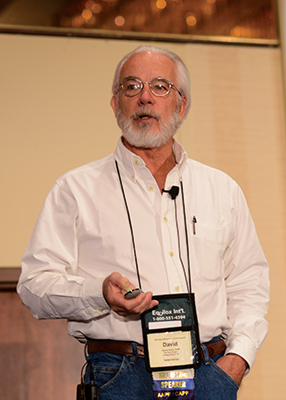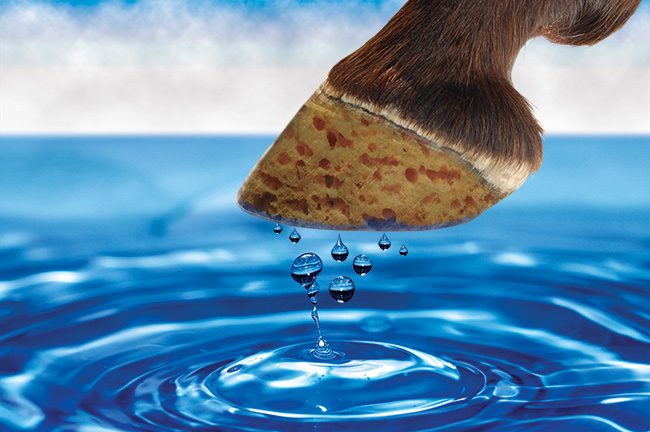There are a few things farriers are pretty sure about regarding moisture in the foot. They come down to:
- Too much is bad.
- Too little is bad.
- Feet that are too dry shrink, get harder and are prone to chip and crack.
- Feet that are too wet are soft, have trouble holding shoes and are mushy.
Farriers in show barns rail against horses that are bathed too often, while shoers in dry, arid areas sometimes ask owners to let water troughs overflow a bit so horses will have to stand in water or mud while drinking, giving their feet a chance to get some moisture. Some hoof coatings are touted for holding in moisture, while others keep it out.
But when scientific tests are used, the results aren’t clear-cut — and they don’t seem to support these commonly held beliefs. Two presenters at the 2013 International Hoof-Care Summit (IHCS) separately noted that the amount of moisture in a hoof doesn’t seem to vary much — no matter what environment the horse lives in.
Brumby Research
Australian hoof researcher Brian Hampson told the Summit audience in Cincinnati, Ohio, that tests on the hooves of brumbies — the feral horses of Australia and New Zealand — found that samples taken from horses from very different environments had virtually the same moisture content: about 30%. Here's a preview of his lecture.

Australian researcher Brian Hampson found no difference in the moisture content of samples taken from the hooves of feral horses, even though the horses lived in very different environments. The feet all had a relative hydration of about 30%, even though they have obvious physical differences.
Brumbies live in three typical environments. Hampson describes one as swampy or boggy, with plenty of water and lush forage. The other two are drier, with much less water and forage. These two differ from each other in the type of ground the horses must travel over. In one, the ground is soft and sandy, while the other is hard and rocky.
As part of his research, samples were taken from the feet of freshly killed horses from all three environments. The samples were weighed, then sealed in glass containers where they were treated with phosphorus pentoxide, a dehydrating agent, to extract the moisture from the samples. After this was done, the samples were weighed again, with the difference between the two weights being the amount of moisture in the original sample.
“You’ll be surprised to find that they are all the same,” said Hampson. “About 30% moisture for each sample.”
He also admitted this is a perplexing finding. The samples clearly look different and as another part of brumby research, a mare had been moved from the swampy to the dry environment. Her feet changed over a few weeks to the smaller, hard foot typically found in the drier terrain.
“As farriers we think we know that moisture makes a difference,” he says. “When we pick up a horse from a boggy area, the hoof is easier to cut.”
The tests were continued by having a still-living brumby stand with one foot immersed in water for 2 hours while another foot was kept dry. Samples were then taken from the hoof wall as well as the sole.
“We found out that with the hoof wall that had been soaked, there was no difference between it and the dry sample,” he said. “But the sole that was soaked did take up moisture from the environment and that made a lot of difference.”
Hampson believes that this test confirms the concept that the hoof capsule does not get much of its moisture from the outside environment. Instead, it comes from the dermis on the inside of the hoof wall. He believes the tubules of the laminae probably do draw up some moisture — but not much.
You May Also Be Interested In...
Tackling Those Extra Tough Hoof Crack Concerns
Nearly 90% of quarter cracks in performance horses are related to hoof balance concerns. The other 10% are due to a pathological incident that somehow compromised the hoof wall. In reality, there’s no simple answer for effectively dealing with various types of hoof cracks. And that’s why we’re offering you the best ideas used by a half-dozen veteran farriers in this in-depth eGuide. It’s jam-packed with field-tested ideas you can immediately put to good use when dealing with all aspects of hoof crack repair and prevention.
Download now »
The moisture levels were also the same as samples taken from non-feral horses.
The results seem to indicate that environmental conditions do not affect moisture content in hoof wall horn. So soaking hooves in water — or keeping them out of it — is not going to change the degree of hydration in hoof horn. It may, however, increase the level of hydration in the sole.
The news about the sole probably comes as little surprise to most farriers, but many are going to need a lot more evidence than this to convince them that that rock-hard desert hoof they just dulled their nippers on isn’t a lot drier than the wet one a hoof knife went through as if it were made of butter, rather than horn.
What Do We Know?

David Hood, veterinarian and researcher from College Station, Texas, believes that moisture does have an effect on the shape and size of the equine foot, but says it is due to other factors besides relative hydration, which does not change due to environment.
David Hood, another IHCS speaker, believes that part of the confusion is due to the fact that hoof hydration is a much more complicated topic than many people realize.
“When it comes to this topic, it seems like people either absolutely know the answer before they start or they don’t understand it at all,” he said.
In fact, says the veterinarian and researcher from the Hoof Diagnostic Rehabilitation Clinic near College Station, Texas, the more you look at the numbers and the data, the more confusing the mechanics become.
Hood has observed the same apparent changes in hooves that most farriers have. Like Hampson, he has studied the changes in hooves when horses are moved from a wet environment to a dry, arid environment. But like Hampson, he also says that research has not found evidence of significant changes in hoof hydration due to the environment.
“Soaking the feet in water does not change the amount of water in the hoof,” he says. “Studies indicate that the permeability gradient in the hoof wall is so high that water can’t get across that surface.”
Most discussion on this topic focuses on just these two possibilities. First, that a change from wet to dry environment affects the moisture content in the feet, or that environment has no effect. But Hood suggests that limiting the possibilities might be the problem.
“Is that environment has or has no effect the only two choices?” he asks. “We’ve observed changes. Are they due to some other effect? Temperature? Hardness? Diet? Altitude? Or are all the observations we are making wrong?”
Things To Consider
If hydration does have an effect, Hood says that we should be able to detect it. But we haven’t.
“But one possibility is that we haven’t detected it because we’re looking at the wrong thing,” he said.
Rather than the observable changes in the hoof being directly attributed to higher water content, could it be an indirect effect of water? Or it is necessary to look at some other factor?
Hood says something to keep in mind is that hoof hydration is not uniform throughout the hoof.
Hoof hydration is the statistic most often used in discussion of moisture in the hoof. Hood describes it as an index of the percentage of wall that is water at any given time.
Hood said that data shows that the hydration varies in the components of the hoof. The frog on an average is 34.6% water. The sole is 35.4% and the hoof wall is 23%. Studies will vary in the totals, but this ratio holds true through all of them.
Hood says this indicates that the harder the tissue, the less the percentage of water. “This doesn’t prove that the amount of water in the tissue is the cause (of the level of hardness), but the relationship is there,” he said.
Data also shows that there is a significant difference in how much hydration is present throughout the hoof wall. Not surprisingly, the amount decreases closer to the outer hoof wall.
“If we go all the way to the dermis, there is 100% relative hydration,” he said. “As we move into the laminar interface, it drops down as lipids go up, dropping down to 20%. It drops all the way down to 2% hydration when we get to the very outer wall.”
Other factors that must be considered include:
- The primary source of moisture in the foot comes through circulation.
- Moisture can exist inside cells, or it can exist in the material around the cells.
- Moisture can move in and out of cells.
- We’re not talking about just water. Water is part of a solution that has two parts, the solvent (fluid) and the solute (things that are dissolved into the solution).
- In the inner hoof wall of the hoof, moisture is in an aqueous solution. Water is the solvent and the solutes are hydrophilic (water loving).
- As we moved toward the outer areas of the wall, the moisture is in an increasingly lipid solution. Water is replaced as the solvent by lipids (cholesterol, sulfates, fats, oils etc.) that can more easily go into the hydrophobic (water-hating) environment. Water actually becomes a particle that can be dissolved in the lipids.
- Water movement within the hoof is always passive. It needs to be pushed or pulled. Hood describes it as “going along for the ride.”
Hood says it’s relatively easy for water to move across the basement membrane from within the foot and into the wall. But this travel becomes much more difficult as it moves toward the increasingly hydrophobic outer wall and very difficult by the time it reaches the outer surface of the wall.
Different Factors
This concentration gradient favors water moving inward through the hoof, rather than out through the wall. Hood says new research indicates that moisture we think of being “lost” as the feet dry out isn’t actually be lost at all. Instead, it’s metabolized as part of the cornification process — the building of new hoof wall.
“This looks like it’s going to be a major discovery about where the water goes,” he says. “It doesn’t go out of the hoof wall. It goes in and is metabolized and comes out as something else: A lipid.”
Hood theorizes that when we see a hoof “shrink” or “expand” in a change in environment, what we actually may be seeing is a change in water volume or a change in cornification.
“The outer hoof wall is made of rigid cells,” he says. “They are surrounded with a cell envelope that doesn’t allow them to swell. Water can move across that wall, but not readily. But if we move into the inner wall, the cells are non-rigid. Water can get across that.”
One possibility is that as water moves inward toward the more hydrophilic areas, the cells of the hoof wall become harder and denser. The less rigid cells beneath them shrink and become smaller. The outer hoof wall, in effect, gets tighter as the cells beneath it shrink. That increased density could be what makes the wall harder and tougher on tools — even though the relative hydration of those cells remains virtually the same.
Regarding environmental effects on the hoof wall, Hood is currently exploring the idea that humidity may play a role.
As part of his research, Hood has been observing the changes in feet of horse moved from an alpine environment in New Mexico, where the relative humidity ranges from 54% to 79%, to the much drier area around College Station, Texas, where relative humidity ranges from 13% to 40%.
“If we move from high to low, wet to dry, we notice that you have to put shoes on these horses or they will go lame,” he said. “Over 4 to 6 months, we find that the horses take a smaller shoe size. Sole hardness goes up and so does the hardness of the wall. ’’
When the horses are moved from low to high, or dry to wet, the opposite effect is seen. The feet grow and the sole and wall become softer and less rigid.
“There seems to be some environmental effect present,” he says. “But if we’re going to say this is due to water, we have to come up with some plausible reason that this can be possible when the wall hydration remains the same.”
Hood theorizes that the difference in hydration between the environment and the interior of the hoof is what moves water through the rigid hoof wall, although at a slow rate. Moisture in the environment is “attracted” to moisture within the hoof.
“We’re proposing that the relative hydration is the primary gradient for moving water through the exterior surface of the hoof wall,” he explains. “As the relative hydration gradient in the environment is always higher than the hoof wall, water will move into the foot. That rate of hydration will be a function of how high the relative hydration is.”
That would explain the differences in hoof hardness that farriers know so well. When the horse moves into a wetter environment, moisture from the air is slowly drawn into the interior of the foot. The cells within the foot expand as they absorb the moisture and the hoof wall itself “stretches,” becoming less dense and adding new cells through the cornification process.
When the horse is moved into a drier environment, the movement of moisture within the hoof continues down hill, as water moves from the outer cells toward the more water-loving cells. The outer cells collapse and the hoof wall shrinks, becoming harder and denser.
Hood plans to continue research on hoof hydration and its effects on hoof shape, health and hoof care.
Related Content









Post a comment
Report Abusive Comment